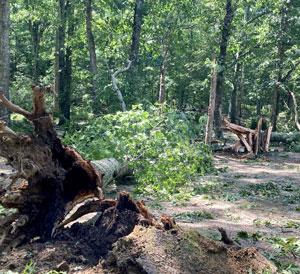Trees and Storms

Whether it takes the form of ice, snow, or wind, a storm can have a significant impact and instantly change a community. Buildings may be damaged or destroyed, power lines downed, and trees broken and torn. Neighborhoods or entire cities may experience a sense of devastation they have never known before. The damage to trees may leave some people feeling at a loss of how to begin recovery. We recommend you familiarize yourself with the information on this page before a storm strikes, since power outages may not allow ready access when needed.
Licensed ArboristsSafety Awareness
Whether you are a city official or a homeowner, the top priority in recovery is always safety. It is a common occurrence that people survive storms and natural disasters only to be injured while cleaning up afterward. Be safe while dealing with damaged and fallen trees.
Related Resources
Assessing Tree Damage & Next Steps
Storms can affect trees in many ways, flooded soils that fail, winds that break and twist limbs, ice that weighs down branches, torn bark, and defoliation can occur in a range from ‘barely noticeable’ to ‘can this tree survive’. But trees can recover from a storm, depending on the kind of damage and its severity. So, before making a final decision to remove a tree, a tree owner can also make some observations that can help make a decision.
Trees are amazingly resilient and many recover with proper care and time. So sometimes the situation may not be as bad as it first appears. Despite the urge to do something immediately, people should try to be patient. As long as there isn’t an immediate physical risk from a damaged tree, it may be possible to keep the tree to see how it responds to the damage.
Responding to storm damage requires several steps:
- Look and Assess the situation.
- Prioritize the work.
- Hire a licensed professional who is a certified arborist with the International Society of Arboriculture.
- Prepare for the future with proper pruning and tree management.
Resources
Community Forest Storm Mitigation Planning
Communities and municipalities should ask themselves if they are prepared to respond to the next storm and manage the resulting tree damage. A community forest storm mitigation plan is an essential part of your community’s hazard mitigation and emergency management plans and systems. There are planning resources to help create a plan for responding to urban tree damage.
Planning should focus specifically on ways to avoid or mitigate the damage trees might cause during storms or other catastrophic events. The plan should also address ways to avoid the loss of trees and tree canopy and thus the benefits from trees that a community enjoys.
Download the Community Forest Storm Mitigation Planning Workbook and accompanying Community Forest Storm Mitigation Plan Template for more about the process, information, and resources. Working through the template through an organized municipal planning session will identify gaps in information and allow for the creation of a cohesive resource to guide preparation for and response to the next storm event.
